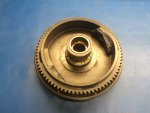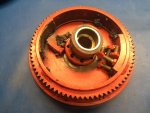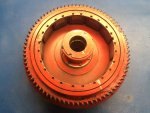Baitcooler
Cadet
- Joined
- Jul 12, 2020
- Messages
- 15
Hi again. New trouble, new topic. This one will be slightly longer so hang in, please.
1988 35hp merc. I rebuilt the fuel pump (bulb wouldn't stay firm). I fixed a mechanical problem with the reverse-lock pushrod. I didn't mention this before, but I'm on my second flywheel. I lost a magnet on the first one which got me into a no-start, no-spark problem I was able to fix with a new flywheel. The flywheel came off of a parts motor I was lucky enough to find locally.
I did my second water test over the weekend.
It was more difficult to start on the ramp than it was in my side-yard trash can. I also had to keep the revs up when in forward or else it would stall immediately. That was new.
I launched and started to run up a creek I sometimes fish. My fishfinders were complaining about low voltage. I stopped to make a few casts. I watched the voltage and with the motor stopped, it was the same. I expected it to go lower with the outboard off (more on this later).
After thinking about how it was hard to start, and my battery was not charging I decided to crank it back up and head back towards the launch ramp. It started about the same as on the launch ramp. At speed it started to lose power intermittently. Maybe one of the cylinders was cutting out? I don't have an ear for these problems, yet.
I kept the hammer down and my fingers crossed. In a bend I ran up on another fisherman anchored putting out live-bait rods. I backed off the throttle. The motor died. I tried to restart it. No luck. The man was very nice and towed me back to the launch ramp!
Monday after work I took the cowling off. I told myself I was only going to look at a few things and not get too dirty before dinner. I tested the rectifier. The rectifier diodes that connect to the positive side were open. That explains the low battery warnings. I'm considering that one sorted.
After the rectifier I pulled the plugs. They looked good. I kept snooping. When examining the motor I noticed a piece of flywheel magnet in the lower cowling. I fished it out. With plugs out, kill-switch yanked, and key out I turned the flywheel by hand and looked at the underside for magnet damage. Chunks were missing.
I popped the flywheel off. There was definitely new magnet damage. The no-start I'm experiencing now eerily resembles the no-start I had when the magnets were damaged on the first flywheel.
What gives? Was this the source of my power loss on the water? How are these magnets so fragile and is there a way to replace them? The flywheels don't seem to exist for my 35, at least where I know to look (ebay). When I ran into this with the first bad flywheel, I tried to replace it with a flywheel from a slightly older 40 and it rubbed on the ignition stator. That's when I got lucky and found my parts motor locally. The magnets on the parts one were also damaged, but it started and ran well enough when I swapped it over.
What else can I eliminate? I should have tried with starter fluid before removing the flywheel, but you know..... hindsight, man..... It cranked hard and smelled like gas on the water. Even with the neutral fast-idle lever pulled all the way up, choke or no choke it didn't fire. I didn't think it was a fuel problem then.
I'll post some pictures later of the flywheels. If you have any info on compatible flywheels for a late 80's 35, or know anything about replacing the magnets I would greatly appreciate it. Thanks!
1988 35hp merc. I rebuilt the fuel pump (bulb wouldn't stay firm). I fixed a mechanical problem with the reverse-lock pushrod. I didn't mention this before, but I'm on my second flywheel. I lost a magnet on the first one which got me into a no-start, no-spark problem I was able to fix with a new flywheel. The flywheel came off of a parts motor I was lucky enough to find locally.
I did my second water test over the weekend.
It was more difficult to start on the ramp than it was in my side-yard trash can. I also had to keep the revs up when in forward or else it would stall immediately. That was new.
I launched and started to run up a creek I sometimes fish. My fishfinders were complaining about low voltage. I stopped to make a few casts. I watched the voltage and with the motor stopped, it was the same. I expected it to go lower with the outboard off (more on this later).
After thinking about how it was hard to start, and my battery was not charging I decided to crank it back up and head back towards the launch ramp. It started about the same as on the launch ramp. At speed it started to lose power intermittently. Maybe one of the cylinders was cutting out? I don't have an ear for these problems, yet.
I kept the hammer down and my fingers crossed. In a bend I ran up on another fisherman anchored putting out live-bait rods. I backed off the throttle. The motor died. I tried to restart it. No luck. The man was very nice and towed me back to the launch ramp!
Monday after work I took the cowling off. I told myself I was only going to look at a few things and not get too dirty before dinner. I tested the rectifier. The rectifier diodes that connect to the positive side were open. That explains the low battery warnings. I'm considering that one sorted.
After the rectifier I pulled the plugs. They looked good. I kept snooping. When examining the motor I noticed a piece of flywheel magnet in the lower cowling. I fished it out. With plugs out, kill-switch yanked, and key out I turned the flywheel by hand and looked at the underside for magnet damage. Chunks were missing.
I popped the flywheel off. There was definitely new magnet damage. The no-start I'm experiencing now eerily resembles the no-start I had when the magnets were damaged on the first flywheel.
What gives? Was this the source of my power loss on the water? How are these magnets so fragile and is there a way to replace them? The flywheels don't seem to exist for my 35, at least where I know to look (ebay). When I ran into this with the first bad flywheel, I tried to replace it with a flywheel from a slightly older 40 and it rubbed on the ignition stator. That's when I got lucky and found my parts motor locally. The magnets on the parts one were also damaged, but it started and ran well enough when I swapped it over.
What else can I eliminate? I should have tried with starter fluid before removing the flywheel, but you know..... hindsight, man..... It cranked hard and smelled like gas on the water. Even with the neutral fast-idle lever pulled all the way up, choke or no choke it didn't fire. I didn't think it was a fuel problem then.
I'll post some pictures later of the flywheels. If you have any info on compatible flywheels for a late 80's 35, or know anything about replacing the magnets I would greatly appreciate it. Thanks!






















